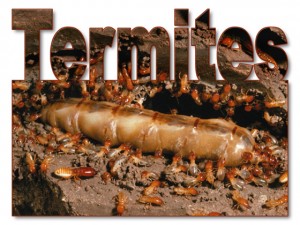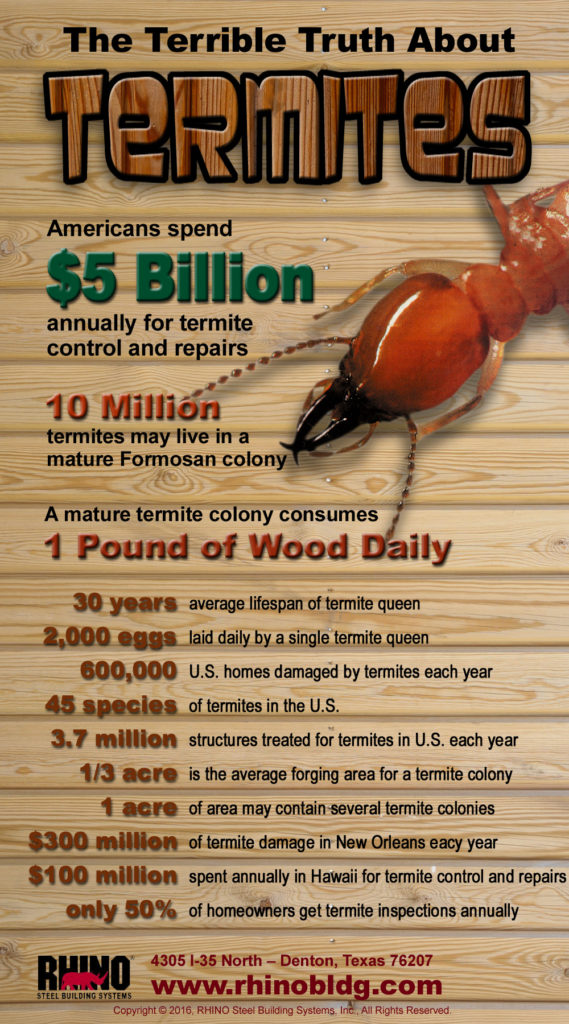Wood Structures Invite Termites to Lunch
Termites look so tiny and harmless. Don’t believe it. Those relentless wood-munching monsters lurk in dark places, quietly devouring every cellulose-filled object in their path.
Outnumbered and Outflanked
The sheer number of termites on this planet boggles the mind. Forty-five different species of termites inhabit the U.S. Worldwide, over 2,700 termite species exist.
 We are completely outnumbered in this fight. Experts estimate there are 1,000 pounds of termites for every human on earth.
We are completely outnumbered in this fight. Experts estimate there are 1,000 pounds of termites for every human on earth.
Termite colonies contain millions of the little creepy crawlers. Formosan colonies populations may reach two to ten million. (I cannot help but wonder who got the job of counting the colony population.)
Termite Facts
In North America, termites are found as far north as British Columbia, Canada. Every state in the U.S.—with the exception of Alaska— hosts some type of termites.
Termites need only two things to thrive and multiply: moisture and organic cellulose material to feed on, including wood, drywall, and paper.
Termites are tireless, working 24/7 to consume wood.
Each termite eats as much as 3% of its own weight each day. That’s equivalent to a 185-pound man consuming 5.5 pounds of food daily! In fact, a mature termite colony may gobble a pound of wood per day.
Termite workers live about four years. Formosan termite queens live 25-30 years, laying 2,000 eggs per day!
In the forests, termites provide beneficial services, breaking down fallen trees and deadwood. However, as urban sprawl spreads across previously rural areas, termites turn their attention to a readily available source of nourishment: wood-framed homes and buildings.
Lumber of any kind attracts termites. Lumber with moisture present is an open invitation to belly up to the wood buffet. Termites can enter a structure through a hole only 1/32” wide.
Dollar for dollar, termites inflict more structural damage than fire, floods, and storms combined.
Formosan termites— among the most voracious of the subterranean termites— can cause extensive structural damage to a wood structure in six months or less in humid climates. Repairs costs may run into thousands of dollars.
 Termites may be munching away inside walls for years before the damage is discovered.
Termites may be munching away inside walls for years before the damage is discovered.
(A woman I know was shocked when she leaned against a wall in her office and her hand went through the wall. Termites in the wall, eaten all the drywall, leaving only the outside layer of paper. They had also been munching away on the wood framing in the wall.)
If the termites go undetected long enough, the home or building might be salvageable.
The U.S. Environmental Protection Agency (EPA) believes that — absent expensive termite treatments with chemical termiticides— 10% of homes receive termite damage.
Insurance rarely covers termite damage, leaving the home or building owner to foot the bill for repairs.
Two Ways to Fight Wood-Chomping Termites
There are two ways to battle termites:
1. Spend hundreds of dollars for repeated harsh chemical treatments to hold termites at bay.
2. Build with steel for termite proof construction.
No termite can make a meal of steel.
Pre-engineered steel buildings never need chemical termicides treatments.
Compared to wood-framed structures, steel buildings are:
• 100% recyclable
• Better for indoor air quality
• Environmentally preferred
• Far more termite-resistant
• Less expensive to insure and operate
• Less likely to incur damage from high winds or heavy snows
• More dimensionally stable
• More durable
• More lightning resistant
• Non-combustible and fire-resistant
• Provide better mold and mildew resistance
• Seismically superior
• Stronger
RHINO Steel Building Systems ships durable prefabricated metal commercial and industrial buildings all across North America. These structures are versatile, functional, long lasting, attractive, economical— and termite resistant.
Call today to learn more about the benefits of steel buildings over wood framing. Speak to a RHINO Metal Building Specialist now by calling 940.383.9566.
Build for the future; build termite proof construction with steel.
